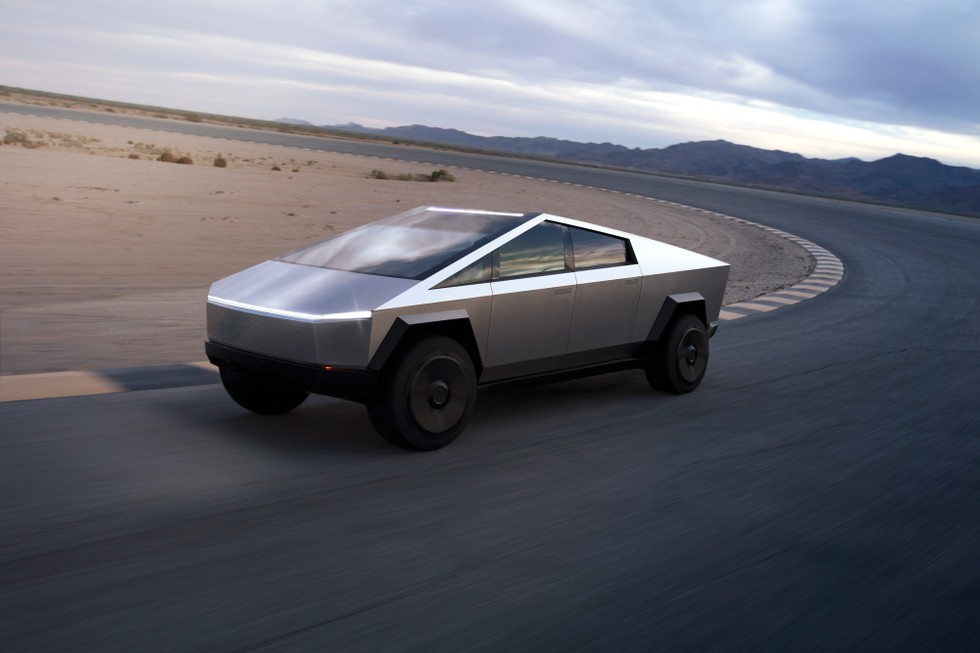The automotive world is in constant evolution. Each year brings forth a wave of innovative technologies that rapidly transform our vehicles. From enhanced functionalities to radical design shifts, the pace of progress is relentless. But what can we truly anticipate from the futuristic cars of tomorrow? Are we on the cusp of unprecedented advancements, or have we already reached the pinnacle of automotive design? Let’s delve into the most captivating technologies, groundbreaking concepts, and eagerly awaited models that are shaping the future of cars.
Tesla Cybertruck: The Unconventional Pioneer
The Tesla Cybertruck navigating a paved road.
No discussion about New Futuristic Cars would be complete without mentioning Tesla’s Cybertruck! This polarizing vehicle, initially revealed in 2019, has faced repeated delays, with 2023 currently slated as its target deployment year.
The Cybertruck’s primary focus is resilience. It boasts an Ultra-Hard 30X Cold-Rolled stainless-steel structural skin, essentially a sophisticated way of emphasizing the vehicle’s exceptionally robust frame. This unique material choice also dictates the car’s distinctive, angular, futuristic aesthetic, as the cold-rolled metal sacrifices flexibility for unparalleled strength.
Despite a now-infamous unveiling event where the Cybertruck’s windows unexpectedly shattered during a demonstration, Tesla asserts that the vehicle’s durability extends to its glass. They claim that ultra-strong glass and polymer-layered composite will effectively absorb and redirect impact forces, ensuring window integrity.
Tesla also boldly states that the Cybertruck will possess a towing capacity exceeding 6,350 kilograms – roughly equivalent to the weight of an adult African bush elephant. These are impressive specifications, and given the numerous delays, there’s ample anticipation to see if the Cybertruck will indeed deliver on these promises when it finally arrives, hopefully in 2023.
BMW iX Flow: The Color-Shifting Chameleon Car
The BMW iX Flow concept car displaying its color-changing e-ink technology.
BMW’s iX Flow, a standout reveal at CES 2022, initially appears conventional, resembling countless cars seen on everyday roads. However, it conceals an extraordinary feature: the ability to change color instantly at the touch of a button.
This remarkable feat is achieved through a color-swapping e-ink ‘paint’. In essence, the car’s exterior is coated in a vast e-reader display comprising millions of microcapsules filled with pigments. Each capsule contains negatively charged white pigments and positively charged black pigments. By altering an electrical field, the desired pigment is brought to the surface, thus changing the car’s color.
The color transformation isn’t limited to the entire vehicle. BMW showcased dynamic displays, including racing stripes, multicolored patterns, and seamless transitions between white and black across the car’s surface.
While reminiscent of technology from a James Bond film, the iX Flow remains a concept. BMW’s plans for commercializing this technology are uncertain, and questions persist about the real-world durability of millions of microcapsules in diverse environmental conditions.
Meta Materials HUD: Holographic Displays for Enhanced Driving
Metamaterial’s holographic Heads-Up Display in an automotive setting.
Heads-Up Displays (HUDs) are a recurring element in science fiction, consistently depicted as a futuristic interface. At CES 2022, Meta Materials presented their take on this technology, utilizing holography to project crucial driving information directly within the driver’s line of sight. Meta Materials argues this approach enhances driver focus by eliminating the need to look down at dashboard displays.
A HUD system minimizes eye strain caused by constant brightness adjustments when shifting focus between the road and in-car instruments. Theoretically, this could improve driver reaction times by keeping their attention consistently on the road ahead. However, like many futuristic car technologies, widespread adoption of HUD systems is still distant and will require rigorous safety approvals before practical implementation in vehicles.
Hyundai Elevate: The Walking Car Concept for Unprecedented Mobility
The Hyundai Elevate concept vehicle envisioned as a taxi, showcasing its robotic legs.
Hyundai’s ‘Elevate’ concept car, unveiled at CES 2019, is undeniably unique within the realm of futuristic car designs. This vehicle ingeniously combines wheels with robotic legs, granting it unparalleled mobility. This hybrid system would enable the car to navigate terrains inaccessible to conventional vehicles, climb stairs for wheelchair accessibility, maneuver into tight parking spaces, or traverse obstacles with ease.
These articulated legs would allow the car to climb and ‘walk’ in situations where wheels prove ineffective. John Suh, Vice President and Head of Hyundai Cradle, explained the concept’s potential in disaster relief scenarios: “When a tsunami or earthquake strikes, current rescue vehicles can only transport first responders to the edges of the debris. They have to travel the rest of the way on foot. ‘Elevate’ can drive into place and climb directly over debris from a flood or pieces of collapsed buildings.”
Canoo Pickup: Modular Functionality for Adaptable Utility
The Canoo pickup truck demonstrating its adaptable design in a snowy environment.
The Canoo Pickup presents a seemingly conventional appearance, save for its generously sized front window. It could easily blend in with everyday vehicles. Eschewing extravagant technology or excessive screens, Canoo prioritizes functionality and modularity. The vehicle’s design is highly adaptable, allowing for interchangeable rooftop accessories, variable size and features, and a pull-out bed that can be extended or retracted to alter the car’s overall dimensions.
This modular approach allows owners to configure the car for different needs – a compact size for city driving or expanded dimensions for maximum cargo capacity on longer journeys. The Canoo Pickup also incorporates hidden storage compartments, extra power outlets, solar panels, and integrated exterior lighting. While not overtly futuristic in technology, the concept of modular vehicle features is a practical innovation rarely seen in the automotive industry.
DS X E-Tense: Reimagining Automotive Luxury and Design
The DS X E-Tense concept car highlighting its innovative and luxurious styling.
DS Automobiles is embracing a fully futuristic design philosophy with its concept cars. Following a naming convention reminiscent of Elon Musk’s children, they’ve christened this model the X E-Tense. This three-seater concept explores technologies such as self-healing bodywork capable of reforming after impacts and windows that dynamically adjust to ambient light levels. The interior features an asymmetrical layout with two seats on one side and a single, additional seat on the opposite rear side.
The interior design is characterized by elaborate styling, vibrant color palettes, and a distinctly futuristic ambiance. As with many concept cars, the X E-Tense’s advanced technologies are largely conceptual. Instead, DS aims to showcase the potential trajectory of future automotive design and technology.
Audi AI: Trail: Off-Road Exploration with Drone Assistance
The Audi AI: Trail concept car visualized in an adventurous off-road scenario.
When Audi unveiled the AI: Trail in 2019, it appeared as a somewhat eclectic fusion of futuristic technological concepts. Features like integrated drones, detachable hammock seats, and expansive glass surfaces define this concept car. However, it provides intriguing insights into potential future automotive directions. Beyond its electric powertrain, the AI: Trail proposes antibacterial, dirt-repellent coatings for armrests and interior surfaces.
The seats are designed as detachable hammocks, removable for camping excursions and simplified cleaning. A more unconventional feature is the suggestion of drones that autonomously precede the car, illuminating the path ahead. While undeniably futuristic, the Audi AI: Trail’s practicality as a blueprint for future cars remains open to interpretation.
Cadillac InnerSpace: Autonomous Luxury and Immersive Experiences
The Cadillac InnerSpace concept car emphasizing its autonomous driving and passenger-focused design.
Another concept unveiled at CES 2022, Cadillac’s InnerSpace design seems directly inspired by distant-future science fiction films. Cadillac states that the InnerSpace concept aims to redefine the driving experience, enabling two passengers to prioritize the journey itself over the act of driving.
The car would feature full autonomous driving capabilities – a long-sought goal for numerous car manufacturers, yet still not fully realized. This autonomy would free occupants to engage with the scenery or personal activities. Cadillac envisions enhancing in-car entertainment through Augmented Reality (AR) engagement.
Further emphasizing passenger comfort, the InnerSpace incorporates tires designed to minimize sound wave resonance for a quieter and more serene ride. Like many cars on this list, the InnerSpace is primarily a concept, representing Cadillac’s vision for future automotive possibilities. However, the core technologies – augmented reality, self-driving systems, and noise reduction – are all currently available; the challenge lies in integrating them effectively and safely into production vehicles.
Sony Vision-S 02: Entertainment and Safety Converge
The Sony Vision-S car interior showcasing its extensive display screens and technology integration.
Do you ever feel your car lacks sufficient screens? Mirroring the trend in concept car design, Sony seemingly adopts the Pimp My Ride philosophy: the more screens, the better the car. With screens for rear passengers and a trio of displays in the front, Sony envisions transforming cars into mobile entertainment hubs. However, the Vision-S 02’s ambitions extend beyond entertainment.
The vehicle would incorporate over 40 sensors to continuously monitor external safety conditions and assist with autonomous driving functionalities, a feature popularized by Tesla. Sony also proposes transitioning to digital mirrors, integrating cameras and displays. A distinctive feature of Sony’s concept is the inclusion of Time of Flight cameras to analyze facial expressions, gestures, and driver fatigue. This data aims to optimize temperature control and provide alerts for drowsiness or necessary driving breaks.
Read more:


